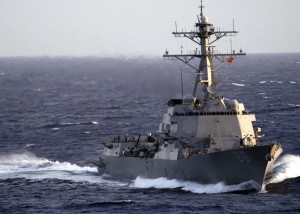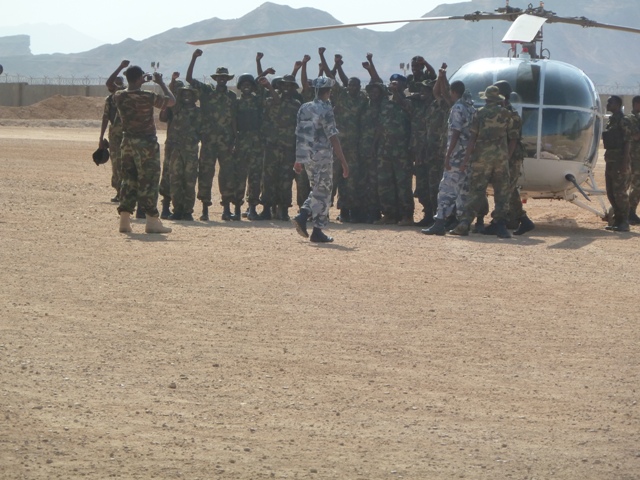An oft-cited draw-back of unmanned air systems is their vulnerability to a variety of threats both physical, such as anti-aircraft fire, and electronic, including jamming. Researchers and industry are beginning to more seriously examine these threats as the number of drones operating proliferates.
How do UAVs stack up against these various threats, especially in the maritime environment?
On the physical front, depending on at what altitude they are operating, maritime UAVs face similar threats to helicopters and patrol aircraft. Small tactical UAS flying surveillance missions at relatively low altitudes over land or water are vulnerable to the simplest anti-aircraft threat, small arms fire. In 2011, a Fire Scout UAV operating from USS Halyburton (FFG 40) over Libya was shot down by some sort of ground fire. While flying over-water, drones might face close-in-weapons systems ranging from 20-30mm to larger naval guns in the 57mm-to-155mm range. Recently, Naval Post Graduate School (NPS) Systems Engineering – Test Pilot School Co-Op students Lieutenants Jacob King and Jared Wolcott completed research on ScanEagle survivability against small arms. Their analysis shows that the overall probability of kill (pk) in a given scenario may exceed 50% against a 12.7mm (.50 caliber) weapon, and that the greatest driving factor in the UAV’s survivability is its slant range to the threat. They recommend upgrades to optics modules to allow the aircraft to operate at higher altitudes which will reduce the probability of detection, increase aiming error and ballistic dispersion, and possibly eliminate small-arms threats altogether by flying above and outside enemy weapons range. Future low-altitude maritime UAS will also be vulnerable to shoot-down from directed energy weapons, such as the laser system which will deploy onboard USS Ponce (AFSB(I) 15) later this summer.
Moving up the spectrum of vulnerabilities, there are several publically released incidents which provide anecdotal evidence on combat losses of UAVs from surface-to-air missiles and manned aircraft. In August 1995, a Predator was shot down over Bosnia. Another Pred was shot down over Kosovo in May 1999 by a 1960s-era Soviet Strela surface-to-air missile. An Iraqi Mig-25 downed another MQ-1 over Iraq on December 23, 2002. The Air Force equipped some Predators with Stinger air-to-air missiles in 2002, but had little success countering the Iraqi air threat. In 2012, Iranian SU-25s tried unsuccessfully to shoot down U.S. Predators over the Arabian Gulf. Also in 2012, Israeli F-16s shot down an Iranian tactical UAV over Israeli territory, then did so again off the coast of Haifa in April 2013. Against modern naval SAMs, lower, slower-flying UAVs would likely be highly vulnerable.
There is little reason that compact chaff and flare systems could not be integrated onto most medium- and large-size UAS platforms to offer them some passive protection from these threats. Perhaps the highest-end protective system against shoulder-launched surface-to-air missiles is the Directional Infrared Countermeasures (DIRCM), which has been fitted on a variety of U.S. fixed- and rotary-wing aircraft. DIRCM detects, tracks, and jams infra-red guided missiles using a FLIR and laser. Raytheon’s Common Infrared Counter-Measures (CIRCM) is designed to be lightweight enough for large UAS platforms. Higher-end UAVs, such as the X-47B, feature infrared and radar signature reduction characteristics, though these measures are not cost-effective on tactical UAVs.
Jamming, spoofing, and environments where communications links and even GPS navigation are jammed are an emerging threat to UAVs. On 4 December 2011, Iran’s cyber warfare unit allegedly brought down a U.S. RQ-170 surveillance UAV in some sort of controlled manner. Enhancing autonomy is one way to add resiliency to UAS operating in an electromagnetically-contested environment. Boeing performed some interesting work on bio-inspired autonomy with ScanEagles, one of the most numerous UAVs operating at sea today. The goal of this experimentation was for the UAVs operating in a swarm of vehicles to form a beyond line of site (BLOS) relay network. In addition to relaying UAV surveillance data and telemetry over-the-horizon without the use of satellite communications, the project demonstrated the ability of a ScanEagle to fly autonomously through a jammed environment, then exfiltrate the data collected via the BLOS relay once it exited the denied area. Read more here on UAV communications relays.
One primary desirable attribute of unmanned aircraft, especially smaller, less expensive types, is that combat losses are much more acceptable than with manned aircraft. Though as the NPS study notes, “the loss of a small UAV does not incur any loss of life or a large cost, the potential loss of the ISR mission it performs is becoming increasingly important to the combatant commanders. The survivability discipline must be applied to UAVs to ensure that these assets become more survivable and can complete their assigned missions in a higher threat environment.”
This article was re-posted by permission from, and appeared in its original form at NavalDrones.com.




